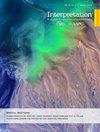一种基于多点随机的浊积岩Lobe结构地质建模方法——以西非下刚果盆地L油田为例
IF 1.1
4区 地球科学
Q3 GEOCHEMISTRY & GEOPHYSICS
Interpretation-A Journal of Subsurface Characterization
Pub Date : 2023-01-10
DOI:10.1190/int-2022-0026.1
引用次数: 0
摘要
作为浊积岩沉积系统的重要组成部分,由于其复杂的沉积层次和明显的非均质性,浊积岩凸角内部结构表征已被证明是必不可少的。本文展示了一种对深水浊积岩单叶结构进行多点随机(MPS)模拟的综合方法。基于测井资料、高频地震资料、深入的构造特征分析和三维训练图像,对刚果盆地下段中新统浊积岩凸起储层进行了基于MPS的地质建模。这项工作有两个目标:(1)扩展具有形态参数的深水浊积岩凸起的地质知识库;(2)开发一种浊积岩地质建模过程,该过程可以在有限的硬数据下表征单个凸起的结构层次。作为第一步,我们使用145米长的岩心、测井和地震分析来分析和表征单凸角元素的特征和沉积分散方式。其次,已经进行了基于浅层地震的浊积岩波瓣采集和测量,以收集浊积岩波瓣形态的定量特征,并将用作地质建模指南。第三,利用地震地质体崩落法(阈值截断法)导出了单波瓣结构元素叠加的三维波瓣复杂训练图像,并基于沉积分布模式进行了增强。然后结合井数据、形态参数、训练图像和地震反演约束进行MPS模拟,得到了一个能够描述单波瓣的结构模型。仿真结果一般遵循波瓣结构元素的形态和叠加。MPS模拟浊积岩-叶复合体结构模型与后井的符合率可达86%。本文给出了一种案例研究的方法,证明了使用多点随机方法进行单浊积岩凸角结构表征的可行性,推荐的方法也可应用于其他领域。本文章由计算机程序翻译,如有差异,请以英文原文为准。
A Multiple Point Stochastic Based Turbidite Lobe Architecture Geo-Modeling: A Case Study from L Oilfield, Lower Congo Basin, West Africa
AAs a prominent component of turbidite deposition systems, turbidite lobe internal architecture characterization has proven essential due to its complicated sedimentary hierarchy and evident heterogeneity. This article demonstrates an integrated methodology for doing multiple point stochastic (MPS) simulation of deep-water turbidite single lobe architecture. Based on logging data, high-frequency seismic data, thorough architectural features analysis and 3D training image, MPS based geological modelling of Miocene turbidite lobe reservoir in Lower Congo Basin are carried out. This effort has two objectives: (1) to expand the geological knowledge base of deep-water turbidite lobes with morphology parameters and (2) to develop a process of turbidite geo-modelling that could characterize the architectural hierarchy of a single lobe with limited hard data. As a first step, we analyze and characterize properties of single lobe elements characteristics and the manner of sedimentary dispersion using 145-meter-long cores, well logging, and seismic analysis. Second, shallow seismic-based turbidites lobes pick-up and measurements to collect quantitative characteristics of turbidite lobes morphology has been conducted and will be used as geo-modelling guidance. Thirdly, a 3D lobe complex training image with single lobe architecture elements superposition is derived by seismic geo-body caving (using threshold truncation) and enhanced based on sedimentary distribution mode. MPS simulation incorporating well data, morphological parameters, training image and seismic inversion constraint is then performed, resulting in an architecture model that could describe single lobes is obtained. The simulation results generally followed the lobe architecture elements morphology and superposition. The coincidence between the MPS simulated turbidites lobe complex architecture model and the posterior well that could reach up to 86%. The article gives a methodology for a case study that proved the implementation of single turbidite lobe architectural characterization using multiple point stochastics, and the recommended process could be applied to other fields.
求助全文
通过发布文献求助,成功后即可免费获取论文全文。
去求助
来源期刊

Interpretation-A Journal of Subsurface Characterization
GEOCHEMISTRY & GEOPHYSICS-
CiteScore
2.50
自引率
8.30%
发文量
126
期刊介绍:
***Jointly published by the American Association of Petroleum Geologists (AAPG) and the Society of Exploration Geophysicists (SEG)***
Interpretation is a new, peer-reviewed journal for advancing the practice of subsurface interpretation.
 求助内容:
求助内容: 应助结果提醒方式:
应助结果提醒方式:


